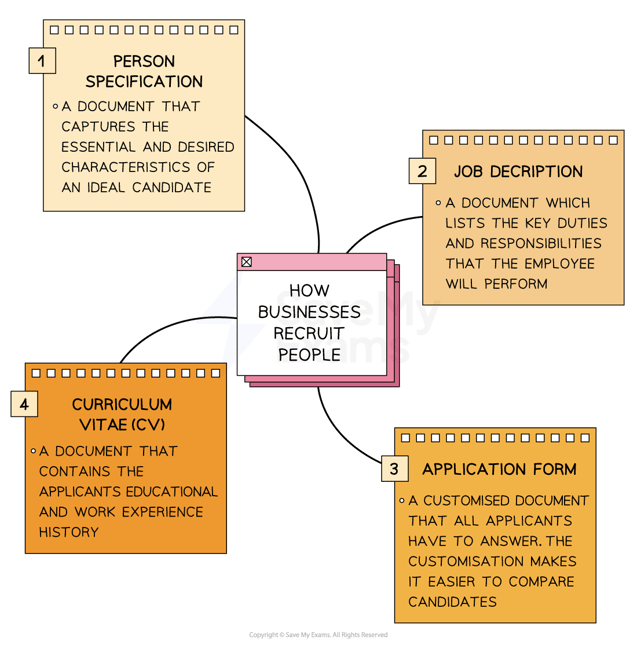- The recruitment process must first identify the job roles that are needed and define the characteristics of the ideal candidates to fill vacancies
- Businesses use a range of documents in the recruitment process
Diagram: Recruitment Documents

The job description, person specification and application form is written by the employer. The CV is written by the prospective employee
- The recruitment documents are used throughout the process and play a very important part in helping the business choose the right candidate for the role
- Without detailed recruitment documentation, prospective candidates may lack the appropriate skills or qualifications needed for the role, or be misinformed about what the role consists of
Job description & person specification
- Before a business starts to look for new employees, it writes a person specification and a job description to determine the job role and ideal candidate to fill that role
A Comparison of the Person Specification & Job Description
| Person Specification |
Job Description |
- Details the essential and desirable characteristics of the person suitable for the job, including
- Qualifications
- Experience
- Skills such as the ability to drive or IT capabilities
- Personal characteristics and attributes
|
- Details the features of the job, including
- Duties
- Hours and location of the job
- Managerial or supervisory responsibilities
- Pay and conditions
|
Application Forms & CVs
- Once a job is advertised, the business accepts applications from candidates via application form or Curriculum Vitae (CV)
Comparing Application Forms & CVs
|
Application Form
|
Curriculum Vitae (CV)
|
|
- Application forms contain a series of standardised questions to which all candidates must respond
- Name and contact details
- Qualifications
- Work experience
- Positions of responsibility
- Interests
- A personal statement where the candidate explains why they would be suitable for the advertised role
- The names and addresses of referees
- Many application forms are now completed online
|
- A curriculum vitae is compiled by the applicant and may be standardised to apply for varied roles
- CVs usually include similar information to that collected in an application form
- Although it should be well laid-out and clear, there is no single acceptable format for CVs
- An accompanying letter of application outlines
- Why the applicant wants the job
- Why they would be suitable for the advertised role
|
|
Benefits of an Application Form
|
Benefits of a CV
|
- All applicants provide identical information in the same format so they are easy to compare
|
- More applicants may apply because it is easier for candidates to prepare and adapt a standard CV
|
Drawbacks of an Application Form
|
Drawbacks of a CV |
- Limited information can be expressed by candidates so key desirable attributes may not be identified
|
- Comparing different formats and content of CVs can take more time and lengthen the recruitment process
|



